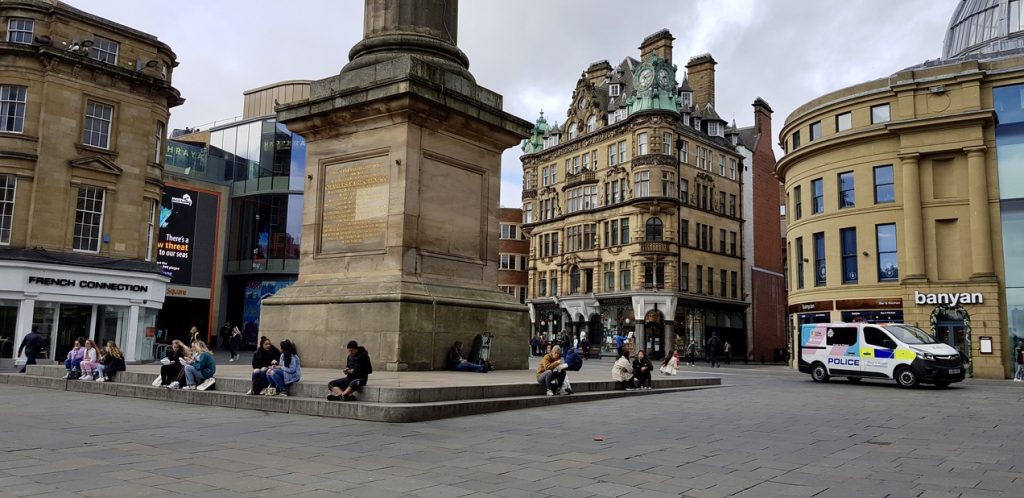Stuart Andrews and Patrick Duggan

In leadership and business contexts, theories of collaboration have multiple modes, models and definitions of what for many in the arts, and beyond, comes organically. For instance, business theorists Colbry, Hurwitz and Adair have developed a ‘grounded theory’ understanding of collaboration that differs from traditional ‘leadership’ models. For these scholars, collaboration is ‘any on-going interpersonal interaction not characterized by a significant power imbalance with the express purpose of achieving common goals’ (2014: 67). Since we first began working together in 2016, our work has always been dialogic and conversational, truly ‘collaborative’ in the non-hierarchical sense captured above. But what such theories perhaps lack, is proper account of the processes that underpin such collaborations. That is, our methodological practices have been about being in a place, together and over a period of some hours, days or weeks.
Where we have been trying to understand the relation of a city to its arts ecologies and practices (and vice versa) being ‘in conversation’ with that place – experiencing performances, walking the streets, meeting the people, eating local food as a shared practice – has been vital. We are ‘in conversation’ literally (with people in a place) and more experientially (being there). This has been at the centre of our work together and with participants and stakeholders in all our projects.
More practically, when writing, we have often sat in-front of the same screen, passing a laptop or keyboard between us as we thought, talked and typed iteratively. Very often this has involved working in non-traditional workspaces: arts centre foyers, cafes and restaurants, parks and public thoroughfares, pubs and bars. Such practices have enabled us to work in unusual patterns and at odd times of the day.
In New Orleans, for example, we would regularly ‘end’ a day of research or workshops by heading to a favourite happy hour or for dinner, determined to decompress and move away from work and onto convivial discussions of family, art, politics or food, perhaps, only to find ourselves caught by an idea, question or possible action that would revive energies and see us working well into the night. Other times, it would be early morning coffee and breakfast that would seed this move into work; our field research has always involved living in self-catering apartments for this reason. Affording one another private space when needed but the informality of shared living space (as opposed to highly trafficked areas of hotel lobbies), we have found such accommodation provides opportunities for happenstance conversation, debate, writing and planning not often granted in other contexts. Perhaps unorthodox, potentially time intensive, these ways of working have been enormously generative for our work on Performing City Resilience. So Covid-19 has been a shock to our research practices, requiring us to renegotiate how and where we collaborate.
This has been a journey of discovery, hesitation and frustration but we have found our way into it and now have a working practice that’s, well, working. It took time… and now we are planning our first field research for the new project we may need to journey to rediscover ways of working in-person (in Covid-secure ways). This return to embodied work – to being in the same place and time as one another and others, alongside the practicalities of getting there (including risk assessments, specific travel ban exemptions and ethics processes) raises real and relevant questions for our project more broadly:
- What does it mean to travel now (April 2021), practically and politically?
- Why are we meeting, do we need to do so?
- What does it mean to think about travelling in the context of sustained social distancing?
- How can we return to travel and to in-person collaborative working in ways that are generative, productive and safe?
- What does social-distancing do to experiences of a place in relation to living, working or visiting that place?
As well as attending to the analysis of our online, digital, archival research to-date, these questions will colour the complexion of our meeting as we grapple with the implications of ‘sustaining social distancing and reimagining city life’.
Beyond that, this trip marks a step change in this research project, an initial move away from digital archive trawling, Zoom performance watching and MS Teams meetings into ways of working and researching that are more familiar. Yet this ‘familiarity’ has been defamiliarized by a year of not meeting, a year of being physically distant from almost everyone around us. Early in the pandemic, psychologist Nisha Gupta contended that
While social distancing is empowering in theory, it can also feel disempowering as a psychological reality due to the loneliness, restlessness, and panic that arises as the days slog slowly and uncertainly (2020: 594)
We have all undoubtedly felt emotions akin to those described above in the last year and craved a return to ‘normality’, to social and physical contact, but what is perhaps less commonly part of the (popular, news media) debate is what that ‘return’ will feel like. What anxieties will arise as people begin to return to spaces of work and collaboration, leisure and community. The need for us to each request (at senior levels) institutional permission to make our impending research trip happen, reveals new practicalities and practices necessary for collaborative working at the moment. Such shifts in daily patterns of living and working, point to wider anxieties about being in proximity to others as the current lockdown lifts. This, in turn, foregrounds the impact of social distancing on the practical mechanics of lived experience and the potential for the emergence of fear and restlessness, a ‘panic that arises’ as the days accelerate towards busier streets and a return to ‘normal’.
References
Colbry, S., Hurwitz, M. and Adair, R., 2014. ‘Collaboration Theory’. Journal of Leadership Education, 13:4, pp. 63 – 75
Gupta, N. 2020. ‘Singing away the social distancing blues: Art therapy in a time of coronavirus’. The Journal of Humanistic Psychology (Special issue on COVID-19), 60:5, 593 – 603.

